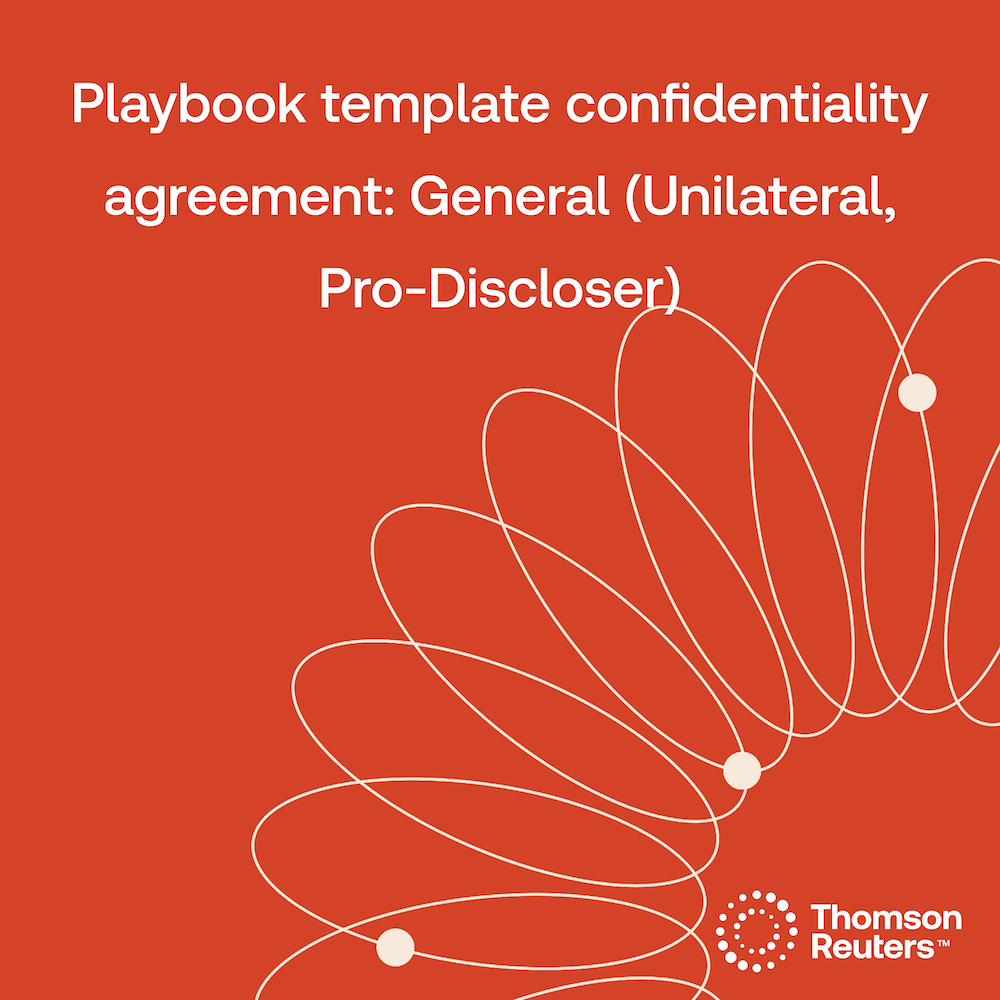Definition, templates, practice notes, and other research resources for attorneys
Legal terms • NDA • confidentiality agreement
In PepsiCo, Inc. v. Redmond (1995), PepsiCo, a well-known company, wanted to prevent the former employee, Redmond, from working for a competitor company as they believed that he would inevitably disclose the trade secrets of PepsiCo despite having signed a confidentiality agreement.
The court, in this case, sided with PepsiCo and set a precedent for the “inevitable disclosure” doctrine, which allowed the companies to seek injunctions that could prevent their former employees from working with competitors if trade secrets were at risk. This case highlights the importance of trade secrets in business and the importance of protecting them.
Confidentiality is of the utmost importance in a corporate or legal setting, as sensitive information is present, and its protection is paramount. To ensure that the information is protected, the parties have the option to bind or be bound by the confidentiality agreement, which means that if any party breaches the terms, the courts will punish them legally. Let’s delve into it to understand it better.
Jump to ↓
| What is a confidentiality agreement? |
| What is a non-disclosure agreement (NDA)? |
| Confidentiality agreements vs NDAs |
Confidentiality agreements and NDA similarities
When to use confidentiality agreements and NDAs
What to do in case of breach of confidentiality agreement
Templates and legal research resources
 |
What is a confidentiality agreement?
A confidentiality agreement is a contract between two or more parties where the parties agree not to disclose information, including trade secrets, proprietary data, and other sensitive business-related details (such as business plans, internal documents, and financial records), deemed confidential. These agreements can be mutual or unilateral.
|
Black’s Law Dictionary
12th ed. 2024
What is a non-disclosure agreement (NDA)?
A Non-Disclosure Agreement (NDA) is a contract where one or more parties agree not to disclose certain proprietary or confidential information they receive during negotiations or employment. NDAs are designed for specific purposes and are not much wider in perspective, as they protect only proprietary information, such as trade secrets, intellectual property, or sensitive data that is exchanged in specific situations.
What are the differences between confidentiality agreements and NDAs?
Confidentiality agreements and NDAs are often used interchangeably due to their similarities (as discussed below), but they have distinct differences, some of which are outlined below.
| Aspect | Confidentiality agreement | Non-disclosure agreement (NDA) |
|---|---|---|
| Definition | A broad agreement to keep various types of information confidential. | A specific agreement to protect proprietary or sensitive information. |
| Scope of information | Covers a wide range of information including trade secrets, business plans, financial records, etc. | Typically limited to specific proprietary information like intellectual property or trade secrets. |
| Mutual vs. unilateral | Often mutual (both parties exchange confidential information). | Usually unilateral (one party discloses), but can be mutual. |
| Duration of obligation | Can last indefinitely or for the duration of the relationship. | Usually for a specific period after the agreement or relationship ends. |
| Legal focus | Can include additional provisions regarding the handling, storage, or return of information. | Focuses specifically on prohibiting unauthorized disclosure. |
| Use cases | Common in employment, partnerships, joint ventures, and legal proceedings. | Common in negotiations, mergers, acquisitions, and product development. |
| Enforceability | Enforced more broadly, with ongoing obligations in some cases. | Enforced specifically for the type of information disclosed. |
| Flexibility | More flexible, covering multiple types of information and contexts. | More focused, generally limited to a specific project or negotiation. |
What is the similarity between confidentiality agreements and NDAs?
Confidentiality agreements and NDAs share the same purpose, namely they both aim to protect the sensitive information of businesses. The following are some of the aspects of similarity:
| Aspect | Commonality |
|---|---|
| Purpose | Both agreements aim to protect sensitive, confidential, or proprietary information. |
| Legal validity | Both are legally binding and enforceable in court if breached. |
| Signatures required | Both require the signing parties to agree to the terms of confidentiality. |
| Penalties for breach | Breach of either agreement can result in legal action or financial penalties. |
| Parties involved | Can involve multiple parties, including individuals, businesses, or organizations. |
| Non-public information | Both protect information that is not intended to be shared publicly. |
Do confidentiality agreements expire?
Confidentiality agreements usually come with an expiration date, often ranging from one to three years. However, some don’t specify an end date and are open-ended, but in this case, the agreement becomes unenforceable if the confidential information goes public, therefore, the confidentiality obligations apply only as long as the information stays private.
When to use confidentiality agreements and NDAs
- When the information to be protected is broader in nature and involves various aspects of business, partnerships, or employment, a confidentiality agreement is ideal.
- If a long-term relationship is expected, such as in joint ventures or employment, where both parties may share sensitive data.
- Where ongoing protection of proprietary business processes and data is required beyond the termination of a relationship.
When to use an NDA
- NDAs are better suited for specific instances where proprietary or sensitive information is shared during short-term business transactions, negotiations, or projects.
- When engaging in preliminary discussions for mergers, acquisitions, or collaborations, NDAs provide focused protection of trade secrets or intellectual property.
- If a company needs to protect a particular type of information, such as technological designs or business plans, during the course of discussions or product development.
What should be done in case of a breach of a confidentiality agreement?
When confidential information is shared, it must be done in a manner that imposes an obligation on the recipient to treat it as confidential and not disclose it. The context and manner of communication play a key role in establishing this obligation, and if there is a breach, then these are the steps that can be used in identifying it:
Identify the breach
Investigate and confirm if the NDA has been violated through monitoring, reviewing, or investigation.
2. Send cease and desist letter
Notify the violator, explain the breach, request to stop further disclosures, and set a deadline.
3. Seek injunctive relief
If the breach continues, file a lawsuit and request a court order to stop further disclosures.
4. Pursue damages
Seek financial compensation if the breach caused harm, like lost profits or damage to reputation.
5. Alternative dispute resolution
Consider resolving the issue through mediation or arbitration to avoid court and reduce costs.
Templates and legal research resources
Confidentiality agreements play a vital role in establishing boundaries for what information is to be shared and what is not. So, if unauthorized information gets shared, it leads to a breach of the agreement, leading to legal consequences.
It’s critical to get the terms of the agreement correct!
But what if you are unsure which clauses are best suited to protect your confidential information and wonder whether your organization’s NDAs will provide you with sufficient legal protection?
Below you’ll find relevant resources from templates, toolkits, and practice notes to help shape your agreement as required.
Templates
Need a standard form to be used in connection with commercial transactions, drafted in favor of the discloser, the recipient, or simply a general standard document ? All these samples contain integrated notes with important explanations and drafting and negotiating tips.
Practice notes
Below, find a Practice Note discussing in the context of US commercial transactions. This Note provides practical tips on developing internal systems and drafting contract provisions designed to protect a company’s sensitive information, including its business assets and relationships, data security, and trade secrets.
For M&A lawyers, begin by exploring the essential aspects of confidentiality agreements such as their principal provisions and key considerations. One of the first agreements signed in most M&A transactions is the confidentiality agreement (or NDA), which ensures that sensitive information remains protected during the initial stages of a deal. Examine whether an agreement should be unilateral or mutual, the timing of signing, and whether it should be separate from or part of the term sheet. Review the importance of defining confidential information, permitted uses, and exclusions. The M&A confidentiality agreement practice note highlights special considerations for public companies, including standstill agreements and compliance with securities laws. The Note also addresses the limitations of NDAs, the necessity of written agreements, and the remedies available for breaches. Additional provisions often included in M&A NDAs, such as non-solicitation clauses, standstill agreements, and anti-clubbing provisions, are also covered. By understanding these elements, parties can better navigate the complexities of confidentiality agreements in M&A transactions. .
Another Practice Note describes trade secrets and confidential information protections available to employers. It examines trade secret definitions and legal recourse, including claims under the federal Defend Trade Secrets Act (DTSA) and state law claims for trade secret misappropriation, tortious interference, breach of duty of loyalty, and breach of fiduciary duty. It also explores relevant restrictive covenants and best practices for US employers. This Note is jurisdiction-neutral.
Related terms:









